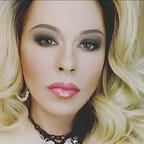Rick and Steve: The Happiest Gay Couple In All The World is the Best Queer Show You Never Saw
In July 2007, a new half-hour comedy debuted on the newly founded LGBT themed cable network, LOGO. Rick and Steve: The Happiest Gay Couple in All the World seemed, on it’s surface, a crudely made show using stop motion animation with characters created out of blocky legos. In theory, the execution was incredibly innovative, even on the very low budget afforded by Toronto based independent production company, Cuppa Coffee Studios.
Created by budding filmmaker, Q. Allan Brocka, Rick and Steve proved to be an inspired masterpiece of social satire that didn’t just match wits with the likes of Comedy Central mainstay, South Park, it literally left it reeling in it’s wake. Rick and Steve made South Park look like a watered down, saccharine Disney Channel series.
The social commentary of Rick and Steve, via Q. Allan Brocka’s genius world view maintained a vastly self-aware tone that parodied with unapologetic humor, much of the LGBT community and the stereotypes that heteronormative society applies to us. The show found no commentary off limits, including HIV, man-boy relationships, drug use, butch/femme lesbian sex, disabilities, discrimination, and the ridiculousness of the skewering perspective of straight people toward queers. In fact, it used that very perspective as a leveraged resource to mock and jab at modern day ideologies of what queer life is like, what we do, and who we are when no one else is looking.
From the onset of the series, with its catchy, ear worm theme song, to the courageous humor that would trigger much of today’s pearl clutching, politically correct audiences, the show gave a big middle finger to conservative concepts and those with fragile sensibilities. The best part about Rick and Steve was it’s blatant exploitation of tropes and its ability to be cleverly self referential without resorting to lazy toilet humor. Part of its charm was in its undeniable intelligence that it intentionally wanted you to think it didn’t possess. Ironically, Rick and Steve was one of the smartest television series in decades, and it was the first to give the queer community permission to laugh at itself via these little lego people who were having blatant conversations about scissoring lesbians and turkey basters or a threesome with a transgender Female-to-Male whose “snap on” snaps off during their orgy.
Who would have thought that a menagerie of lego puppets could provoke such hilarity as it lampooned queer culture? By todays standards, such a ballsy show might be protested off the airwaves by the legions of young liberals who have become hyperprotective and extraordinarily committed to political correctness. We occupy a world now where the rules are pretty firm: You can’t say that. You can’t do that. You can’t show that. You can’t laugh at that. Thankfully, before we became indelibly married to our own penchant to rail against anything that might be deemed moderately offensive — especially when it comes to humor, Rick and Steve gave us two unforgettable seasons that will go down in the annals of queer animated television history, not just as the first to feature an interracial gay couple, but to deliberately play to the ridiculousness of the same mainstream hive-mind we’re still fighting against today.
Despite being a small production, Rick and Steve, boasted a diverse cast of notable queer and queer friendly performers. Everyone from Wilson Cruz, cartoon voice legend Billie West, Alan Cumming, Judy Garland’s daughter Lorna Luft, legendary comedian Margaret Cho, Drag superstar Rupaul, N’Sync boyband member Lance Bass, Star Trek Alum George Takei, Star Wars hero Mark Hamill and Bruce Vilanch among countless other gay and lesbian icons lended their voices to some unforgettable characters. The punchy, provocative content spoke for itself. The show gave the queer community their equivalent to Family Guy, except it was better. It dared to go places that very few shows, if any at all, dared to go, and it’s message, if one was to be found, seemed to be an empowering one: “If the world hates you, remember it hated me first, and I don’t care.”
Since Rick and Steve, there has never been another television show that has come remotely close to achieving the groundbreaking humor it fearlessly demonstrated with each rigid movement. You forgot you were watching toys, which serendipitously lent itself to the irony of the caricatures of the queer community that middle America believes we are. You have Kirsten, the lipstick lesbian, Dana, her self described “Bulldyke” wife — well before gay marriage was legalized. There’s also Chuck, an elderly HIV positive man bound to a wheelchair because he is “Paralyzed from the left testicle down” and his shallow, 19 year old twink boyfriend Evan who relies on a myriad of recreational drugs to function. These character would send young college aged activists spiraling into a state of chaos, running for their xanax to deal with this series unless they realize it is the antithesis of sexual, gender, tradition and social comformity. It pushes against the grain of a heavily politicized society that has stolen our right to laugh at ourselves and enjoy parody without feeling guilty.
It’s been 10 years now since Rick and Steve left the airwaves, and maybe someone should reach out to Q. Allan Brocka, the mastermind behind what truly was The Happiest Gay Couple In All The World, and remind him that his pioneering series didn’t just help shape queer entertainment, but we need the laughs now more than ever.
